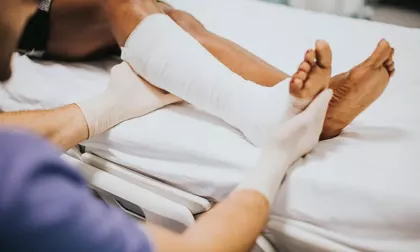Your Questions Answered About Bone Fractures

Frequently asked questions about bone fractures.
How do I determine my risk of getting a fracture?
If you have never looked into whether or not you’re at risk for a bone fracture, Southern Oregon Orthopedics has something for you today. Here is a completely free tool from americanbonehealth.org to help you understand your chances of a fracture if you are age 45 or older. It will ask you some questions, takes just a couple of minutes, and will provide a printable graphic at the end. In addition to the easy-to-read graph, it will provide a chart with steps to take for your particular risk category. Dr. Bents and Dr. Van Horne are always happy to discuss ways to keep your bones strong. Fractures can dramatically impact your health and lifestyle, so it’s always best to avoid them. Calculate your fracture risk with the following quiz: ABH Fracture Risk Calculator
Are vegans at significantly higher risk of bone fractures?
Study results show that people on a vegan diet showed increased incidences of bone fractures included that vegetarians and pescatarians also showed similar increases. The vegan diet is typically lower in calcium and protein because vegans do not eat anything that comes from animals, which are primary sources of these nutrients. In this study that came out of BMC Medicine, vegans were at an average 43% higher risk for fractures than those who ate meat. Fractures were found throughout the body, but mainly hips and legs. The biggest difference came in hip fractures, where vegans were 2.3 times more likely to have than those people who ate meat. Previous studies have shown that supplemental calcium and vitamin D help offset these risks, but that was admittedly not investigated for this particular study. More research needs to be done to include data on those who take supplements. To read the fine points of this recent information, here is a link to a great article put out by MedicalNewsToday.com: https://www.medicalnewstoday.com/articles/vegan-diets-may-be-linked-to-…
Fractures after a fall…could it mean something bigger is going on?
We all have risen from either lying down or sitting and felt a little dizzy. For some, this ends up with a complete, uncontrolled fall to the ground that results in a fracture. Simply reported, you might write it off as an isolated accident. Dizziness, or lightheadedness, can be a sign of something greater. The technical word for the drop in blood pressure that leads to the dizziness is called orthostatic hypotension. According to a New York Times article in August, a significant number of falls and the resulting fractures are likely the result of orthostatic hypotension, especially in older age groups. It can be a risk factor for heart attacks and strokes, or a warning sign for some heart and neurologic disorders. Research is being done as to what orthostatic blood pressures might indicate, such as an early indicator of diabetes or Parkinson’s Disease. If someone you love has a fall, be an advocate by making sure the dizziness investigated. We are a big advocate for preventing fractures. Our highly trained staff are here for you if you get a fracture, but we’d rather you didn’t have to experience the pain and inconvenience of one. Let your providers know if dizziness was the cause of your fracture or the fracture of someone you love.
A bone break, a fracture, a crack in the bone…what’s the difference?
You might have heard people refer to a bone injury as, “just a crack” or “completely broken.” Have you wondered what those terms mean medically? Believe it or not, in professional healthcare, the term fracture should be used for anything that has disrupted the continuity of the bone. Some medical professionals have spoken out about this because of media misinformation. Whether the bone is in 5 pieces or has a hairline crack, it’s a fracture, no matter what the medical television shows present.
How is a sprain different from a fracture?
Now that you know the word ‘fracture’ is the appropriate term for cracks or breaks in a bone, where does a sprain enter into the mix of terms? First, you have to understand that a sprain happens at a joint. A joint is not a bone, so it could not be termed a fracture because fractures are injuries to the BONE. Sprains involve injuries to the ligaments and surrounding tissues at the joint. Both hurt really badly and both will swell. So how can you tell the difference between a fracture and a sprain? An x-ray; it reveals what is going on beneath the skin. Southern Oregon Orthopedics has an in-house x-ray technician ready to take care of your x-ray needs here in Southern Oregon.
Fractures happen; Southern Oregon Orthopedics is here for you
Each year in the United States, there are about 7 million fractures that are seen by medical professionals. If you consider the population of the US, that means everyone has approximately a 2% chance of breaking a bone in any given year. The average person can expect to have 2 fractures in a lifetime, with men seeing a slightly higher chance than women of having a fracture. Southern Oregon Orthopedics wants to be your source of help if you ever have a fracture. Did you know Southern Oregon Orthopedics offers x-rays at a lower cost than ER’s or urgent care clinics? Southern Oregon Orthopedics is happy to take off some of the financial stress during this initial phase of injury investigation. We care, and you will feel this from right from the start. Call our caring staff for your appointment now: 541-472-0603.